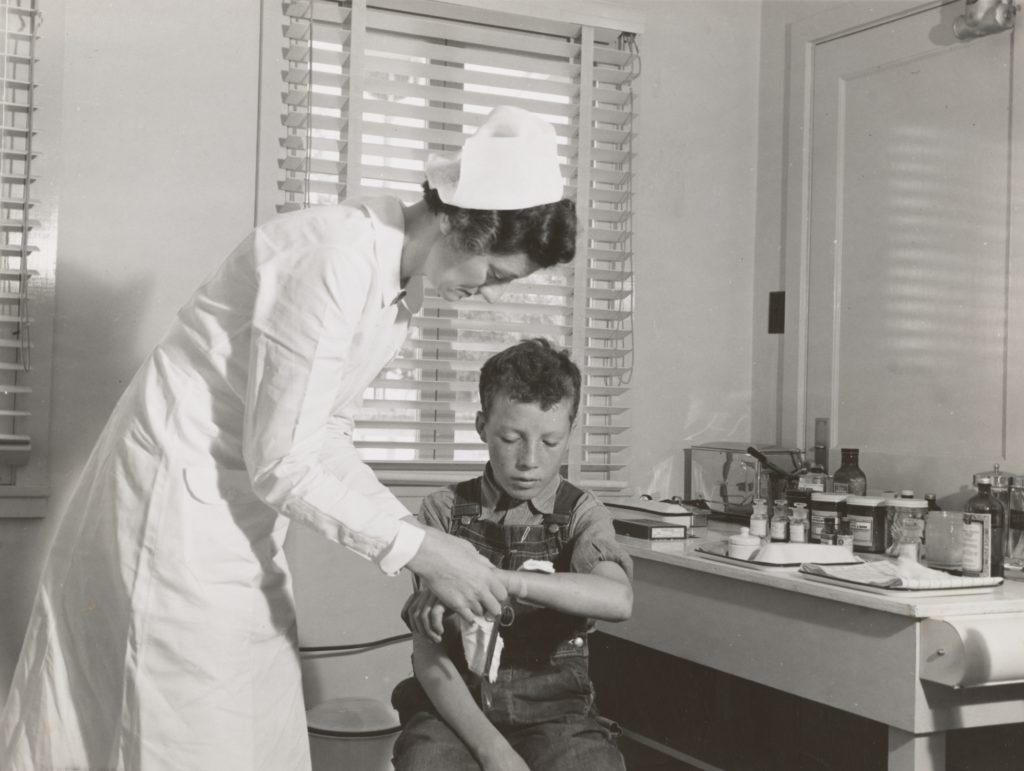Nursing pins, medical jewelry, and even scrubs proudly display the symbols representing the power and responsibility of nurses. When you see a person wearing one of these symbols, there is instant identification. Even if a nurse is not in scrubs and on the job, you know what they do for a living just by seeing one of the symbols.

Two symbols are synonymous with nursing: the caduceus and the oil lamp. Each has a different origin story and meaning. Let’s take a look at each of these nursing symbols and dive into their history.
In this article, we will explore:
Get job matches in your area + answers to all your nursing career questions

The caduceus: the most recognized nursing symbol
In Greek mythology, Hermes was the god of boundaries. One of his most important tasks was to guide the souls of the deceased into the afterlife. He was often depicted with a caduceus in his left hand. The caduceus is an odd-looking staff that is entwined by two serpents. Some versions also include a pair of wings at the top of the staff.
If you are wondering what a snake has to do with medicine, you’re not alone. In ancient Greece, the snake represented longevity and immortality. While the medical profession is not in the business of making you immortal, it does help prolong your life. Another possibility for the snake has religious roots. Moses carried a pole with a bronze serpent on it that he used to cure people who were bitten by snakes in 1400 BC. In both examples, the snake as a representation of healing makes sense.
In 1902, the Medical Department of the United States adopted the caduceus as its official symbol. All medical officer uniforms included the caduceus. Other U.S. medical divisions use the caduceus, including the U.S. Navy Pharmacy Division, U.S. Military Nurses, and the U.S. Public Health Service.
Medical doctors, nurses, and other healthcare practitioners have associated this symbol with their profession for centuries. Turns out, it was a bit of a mistake to connect the caduceus to the practice of medicine.
The caduceus “oops” factor
Examining the design elements within the caduceus helps with understanding why medical practitioners adopted the symbol. At one point in history, roughly 76% of all healthcare professions were using the caduceus. Others have come to realize the mistake in doing so and have shifted their medical branding to another symbol that makes more sense: the Staff of Asclepius.
So, what does the Staff of Asclepius have that the caduceus does not? The short answer is one less snake. In addition to that, the Staff of Asclepius was carried by a skilled physician who was revered as a Greco-Roman god of healing. Despite this misclassification, some professional medical organizations and providers continue to use the caduceus due to the public’s association with it as a symbol of healthcare providers.
The oil lamp: a lesser-known symbol
When you talk about the history of nursing and nursing symbols, you must include one of the most famous women in British history. Florence Nightingale is credited as the founder of modern nursing practice and is synonymous with the oil lamp. Why a lamp? She often cared for the sick and injured during the nighttime hours, carrying a lamp with her so she could see.
Florence Nightingale’s dedication to her craft paved the way for all future nurses. She shared her medical skills and compassion with those who needed them most, regardless of the situation. She inspired other young women to enter the nursing profession, providing them with a training school where they could learn their craft.
To this day, nurses entering the healthcare field recite “The Florence Nightingale Pledge.” They also may receive a lamp pin at their nursing school graduations to symbolize the importance of this nursing pioneer. Some professional nursing organizations, including the International Council for Nurses, use the lamp in their official logos.
Traditional cap and uniform
While they are no longer in circulation, we would be remiss if we did not discuss the identifying qualities of the traditional cap and uniform for nurses. Watch any old TV show with nurses and you undoubtedly will spy nurses wearing the tell-tale nursing cap atop their heads.
Nursing caps were originally a nod to the deaconesses who attended and cared for the sick and dying. Florence Nightingale wanted to honor the tradition while at the same time giving nurses a distinguishable look. The caps were also practical as they helped keep a nurse’s hair neatly in place. Traditional caps are “old hat” in nursing today and were exchanged for skull caps that offer greater protection to patients.

Starched white nursing uniforms, complete with stockings and white shoes, are how nurses dressed during Florence Nightingale’s days in the profession. These restrictive uniforms began to shift in style in the 1950s and 1960s, especially with more men entering the profession. By the 1990s, scrubs were introduced and became an instant hit among nurses for their comfort.
Explore career options in nursing and work at the job of your dreams – no starched uniform or cap required!
Top nurse jobs on Incredible Health
Cath Lab Nurse (RN)
Secaucus, NJ | $65,560 to $100,870 /year
Operating Room / Surgical Nurse (RN)
Fresno, CA | $65,000 to $145,000 /year
Registered Nurse – Ambulatory
Boston, MA | $75,000 to $161,000 /year
Registered Nurse – Behavioral Health
Bridgeport, CT | $61,340 to $120,000 /year
Registered Nurse – Infusion
Cleveland, OH | $61,790 to $98,160 /year
Get matched with these and thousands more permanent jobs on Incredible Health.
